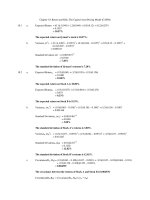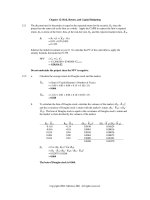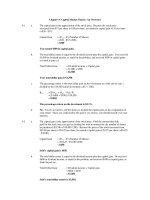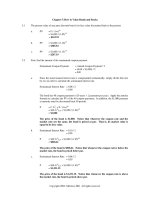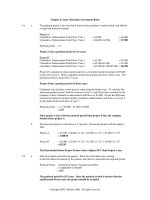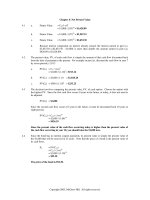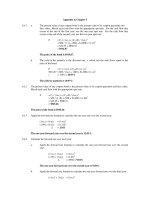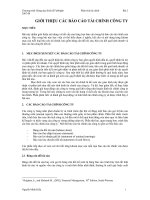Tài liệu Tài chính doanh nghiệp ( Bài tập)_ Chapter 15 pdf
Bạn đang xem bản rút gọn của tài liệu. Xem và tải ngay bản đầy đủ của tài liệu tại đây (232.03 KB, 33 trang )
Chapter 15: Capital Structure: Basic Concepts
15.1 a. Since Alpha Corporation is an all-equity firm, its value is equal to the market value of its outstanding
shares. Alpha has 5,000 shares of common stock outstanding, worth $20 per share.
Therefore, the value of Alpha Corporation is $100,000 (= 5,000 shares * $20 per share).
b. Modigliani-Miller Proposition I states that in the absence of taxes, the value of a levered firm equals
the value of an otherwise identical unlevered firm. Since Beta Corporation is identical to Alpha
Corporation in every way except its capital structure and neither firm pays taxes, the value of the two
firms should be equal.
Modigliani-Miller Proposition I (No Taxes): V
L
=V
U
Alpha Corporation, an unlevered firm, is worth $100,000 (V
U
).
Therefore, the value of Beta Corporation (V
L
) is $100,000.
c. The value of a levered firm equals the market value of its debt plus the market value of its equity.
V
L
= B + S
The value of Beta Corporation is $100,000 (V
L
), and the market value of the firm’s debt is $25,000
(B).
The value of Beta’s equity is: S = V
L
– B
= $100,000 - $25,000
= $75,000
Therefore, the market value of Beta Corporation’s equity (S) is $75,000.
d. Since the market value of Alpha Corporation’s equity is $100,000, it will cost $20,000 (= 0.20 *
$100,000) to purchase 20% of the firm’s equity.
Since the market value of Beta Corporation’s equity is $75,000, it will cost $15,000 (= 0.20 *
$75,000) to purchase 20% of the firm’s equity.
e. Since Alpha Corporation expects to earn $350,000 this year and owes no interest payments, the
dollar return to an investor who owns 20% of the firm’s equity is expected to be $70,000 (= 0.20 *
$350,000) over the next year.
While Beta Corporation also expects to earn $350,000 before interest this year, it must pay 12%
interest on its debt. Since the market value of Beta’s debt at the beginning of the year is $25,000,
Beta must pay $3,000 (= 0.12 * $25,000) in interest at the end of the year. Therefore, the amount of
the firm’s earnings available to equity holders is $347,000 (= $350,000 - $3,000). The dollar return
to an investor who owns 20% of the firm’s equity is $69,400 (= 0.20 * $347,000).
f. The initial cost of purchasing 20% of Alpha Corporation’s equity is $20,000, but the cost to an
investor of purchasing 20% of Beta Corporation’s equity is only $15,000 (see part d).
In order to purchase $20,000 worth of Alpha’s equity using only $15,000 of his own money, the
investor must borrow $5,000 to cover the difference. The investor must pay 12% interest on his
borrowings at the end of the year.
Since the investor now owns 20% of Alpha’s equity, the dollar return on his equity investment at the
end of the year is $70,000 ( = 0.20 * $350,000). However, since he borrowed $5,000 at 12% per
annum, he must pay $600 (= 0.12 * $5,000) at the end of the year.
Therefore, the cash flow to the investor at the end of the year is $69,400 (= $70,000 - $600).
Notice that this amount exactly matches the dollar return to an investor who purchases 20% of
Beta’s equity.
Strategy Summary:
1. Borrow $5,000 at 12%.
2. Purchase 20% of Alpha’s stock for a net cost of $15,000 (= $20,000 - $5,000 borrowed).
g. The equity of Beta Corporation is riskier. Beta must pay off its debt holders before its equity holders
receive any of the firm’s earnings. If the firm does not do particularly well, all of the firm’s earnings
may be needed to repay its debt holders, and equity holders will receive nothing.
15.2 a. A firm’s debt-equity ratio is the market value of the firm’s debt divided by the market value of a
firm’s equity.
The market value of Acetate’s debt $10 million, and the market value of Acetate’s equity is $20
million.
Debt-Equity Ratio = Market Value of Debt / Market Value of Equity
= $10 million / $20 million
= ½
Therefore, Acetate’s Debt-Equity Ratio is ½.
b. In the absence of taxes, a firm’s weighted average cost of capital (r
wacc
) is equal to:
r
wacc
= {B / (B+S)} r
B
+ {S / (B+S)}r
B
S
where B = the market value of the firm’s debt
S = the market value of the firm’s equity
r
B
= the pre-tax cost of a firm’s debt
B
r
S
= the cost of a firm’s equity.
In this problem: B = $10,000,000
S = $20,000,000
r
B
= 14%
The Capital Asset Pricing Model (CAPM) must be used to calculate the cost of Acetate’s equity (r
S
)
According to the CAPM: r
S
= r
f
+ β
S
{E(r
m
) – r
f
}
where r
f
= the risk-free rate of interest
E(r
m
) = the expected rate of return on the market portfolio
β
S
= the beta of a firm’s equity
In this problem: r
f
= 8%
E(r
m
) = 18%
β
S
= 0.9
Therefore, the cost of Acetate’s equity is:
r
S
= r
f
+ β
S
{E(r
m
) – r
f
}
= 0.08 + 0.9( 0.18 – 0.08)
= 0.17
The cost of Acetate’s equity (r
S
) is 17%.
Acetate’s weighted average cost of capital equals:
r
wacc
= {B / (B+S)} r
B
+ {S / (B+S)}r
B
S
= ($10 million / $30 million)(0.14) + ($20 million / $30 million)(0.17)
= (1/3)(0.14) + (2/3)(0.17)
= 0.16
Therefore, Acetate’s weighted average cost of capital is 16%.
c. According to Modigliani-Miller Proposition II (No Taxes):
r
S
= r
0
+ (B/S)(r
0
– r
B
)
B
where r
0
= the cost of capital for an all-equity firm
r
S
= the cost of equity for a levered firm
r
B
= the pre-tax cost of debt
B
In this problem: r
S
= 0.17
r
B
= 0.14
B
B = $10,000,000
S = $20,000,000
Thus: 0.17 = r
0
+ (1/2)(r
0
– 0.14)
Solving for r
0:
r
0
= 0.16
Therefore, the cost of capital for an otherwise identical all-equity firm is 16%.
This is consistent with Modigliani-Miller’s proposition that, in the absence of taxes, the cost of
capital for an all-equity firm is equal to the weighted average cost of capital of an otherwise identical
levered firm.
15.3 Since Unlevered is an all-equity firm, its value is equal to the market value of its outstanding
shares. Unlevered has 10 million shares of common stock outstanding, worth $80 per share.
Therefore, the value of Unlevered is $800 million (= 10 million shares * $80 per share).
Modigliani-Miller Proposition I states that, in the absence of taxes, the value of a levered firm equals
the value of an otherwise identical unlevered firm. Since Levered is identical to Unlevered in every
way except its capital structure and neither firm pays taxes, the value of the two firms should be
equal.
Modigliani-Miller Proposition I (No Taxes): V
L
=V
U
Therefore, the market value of Levered, Inc., should be $800 million also.
Since Levered has 4.5 million outstanding shares, worth $100 per share, the market value of
Levered’s equity is $450 million. The market value of Levered’s debt is $275 million.
The value of a levered firm equals the market value of its debt plus the market value of its equity.
Therefore, the current market value of Levered, Inc. is:
V
L
= B + S
= $275 million + $450 million
= $725 million
The market value of Levered’s equity needs to be $525 million, $75 million higher than its current
market value of $450 million, for MM Proposition I to hold.
Since Levered’s market value is less than Unlevered’s market value, Levered is relatively
underpriced and an investor should buy shares of the firm’s stock.
15.4 a. Since the market value of Knight’s equity is $1,714,000, 5% of the firm’s equity costs $85,700 (=
0.05 * $1,714,000).
Since the market value of Veblen’s equity is $2,400,000, 5% of the firm’s equity costs $120,000 (=
0.05 * $2,400,000). In order to compare dollar returns, the initial net cost of both positions should
be the same. Therefore, the investor will borrow $34,300 (= $120,000 - $87,500) at 6% per annum
when purchasing $120,000 of Veblen’s equity for a net cost of $85,700 (= $120,000 - $34,300).
An investor who owns 5% of Knight’s equity will be entitled to 5% of the firm’s earnings available
to common stock holders at the end of each year. While Knight’s expected operating income is
$300,000, it must pay $60,000 to debt holders before distributing any of its earnings to stockholders.
Knight’s expected earnings available to stockholders is $240,000 (= $300,000 -$60,000).
Therefore, an investor who owns 5% of Knight’s stock expects to receive a dollar return of
$12,000 (= 0.05 * $240,000) at the end of each year based on an initial net cost of $85,700.
An investor who owns 5% of Veblen’s equity will be entitled to 5% of the firm’s earnings at the end
of each year. Since Veblen is an all-equity firm, it owes none of its money to debt holders and can
distribute all $300,000 of its earnings to stockholders. An investor who owns 5% of Veblen’s equity
will expect to receive a dollar return of $15,000 at the end of each year. However, since this investor
borrowed $34,300 at 6% per annum in order to fund his equity purchase, he owes $2,058 (= 0.06 *
$34,300) in interest payments at the end of each year. This reduces his expected net dollar return to
$12,942 (= $15,000 - $2,058).
Therefore, an investor who borrows $34,300 at 6% per anunm in order to purchase 5% of
Veblen’s stock will expect to receive a dollar return of $12,942 at the end of the year for an
initial net cost of $85,700.
For a net cost of $85,700, purchasing 5% of Veblen’s equity yields a higher expected dollar return
than purchasing 5% of Knight’s equity.
b. Both of the above two strategies cost $85,700. Since the dollar return to the investment in Veblen is
higher, all investors will choose to invest in Veblen over Knight.
The process of investors purchasing Veblen’s equity rather than Knight’s will cause the market value
of Veblen’s equity to rise and the market value of Knight’s equity to fall. Any differences in the
dollar returns to the two strategies will be eliminated, and the process will cease when the total
market values of the two firms are equal.
15.5 Before the restructuring the market value of Grimsley’s equity was $5,000,000 (= 100,000 shares *
$50 per share). Since Grimsley issues $1,000,000 worth of debt and uses the proceeds to repurchase
shares, the market value of the firm’s equity after the restructuring is $4,000,000 (= $5,000,000 -
$1,000,000). Because the firm used the $1,000,000 to repurchase 20,000 shares, the firm has 80,000
(100,000 – 20,000) shares outstanding after the restructuring. Note that the market value of
Grimsley’s stock remains at $50 per share (= $4,000,000 / 80,000 shares). This is consistent with
Modigliani and Miller’s theory.
Since Ms. Hannon owned $10,000 worth of the firm’s stock, she owned 0.2% (= $10,000 /
$5,000,000) of Grimsley’s equity before the restructuring. Ms. Hannon also borrowed $2,000 at
20% per annum, resulting in $400 (= 0.20 * $2,000) of interest payments at the end of the year.
Let Y equal Grimsley’s earnings over the next year. Before the restructuring, Ms. Hannon’s payout,
net of personal interest payments, at the end of the year was:
(0.002)($Y) - $400
After the restructuring, the firm must pay $200,000 (= 0.20 * $1,000,000) in interest to debt holders
at the end of the year before it can distribute any of its earnings to equity holders. Also, since the
market value of Grimsley’s equity dropped from $5,000,000 to $4,000,000, Ms. Hannon’s $10,000
holding of stock now represents 0.25% (= $10,000 / $4,000,000) of the firm’s equity. For these two
reasons, Ms. Hannon’s payout at the end of the year will change.
After the restructuring, Ms. Hannon’s payout at the end of the year will be:
(0.0025)($Y - $200,000) - $400
which simplifies to:
(0.0025)($Y) - $900
In order for the payout from her post-restructuring portfolio to match the payout from her pre-
restructuring portfolio, Ms. Hannon will need to sell 0.05% (= 0.0025 – 0.002) of Grimsley’s equity.
She will then receive 0.2% of the firm’s earnings, just as she did before the restructuring. Ignoring
any personal borrowing or lending, this will change Ms. Hannon’s payout at the end of the year to:
(0.002)($Y - $200,000)
which simplifies to:
(0.002)($Y) - $400
Therefore, Ms. Hannon must sell $2,000 (= 0.0005 * $4,000,000) of Grimsley’s stock and eliminate
any personal borrowing in order to rebalance her portfolio. Her new financial positions are:
Value of Total Total
Grimsley Shares Borrowing Lending
Ms. Hannon 8,000$ -$ -$
Since Ms. Finney owned $50,000 worth of the firm’s stock, she owned 1% (= $50,000 / $5,000,000)
of Grimsley’s equity before the restructuring. Ms. Finney also lent $6,000 at 20% per annum,
resulting in the receipt of $1,200 (= 0.20 * $6,000) in interest payments at the end of the year.
Therefore, before the restructuring, Ms.Finney’s payout, net of personal interest payments, at the end
of the year was:
(0.01)($Y) + $1,200
After the restructuring, the firm must pay $200,000 (= 0.20 * $1,000,000) in interest to debt holders
at the end of the year before it can distribute any of its earnings to equity holders. Also, since the
market value of Grimsley’s equity dropped from $5,000,000 to $4,000,000, Ms. Finney’s $50,000
holding of stock now represents 1.25% (= $50,000 / $4,000,000) of the firm’s equity. For these two
reasons, Ms. Finney’s payout at the end of the year will change.
After the restructuring, Ms. Finney’s payout at the end of the year will be:
(0.0125)($Y - $200,000) + $1,200
which simplifies to:
(0.0125)($Y) - $1,300
In order for the payout from her post-restructuring portfolio to match the payout from her pre-
restructuring portfolio, Ms. Finney will need to sell 0.25% (= 0.0125 – 0.01) of Grimsley’s equity.
She will then receive 1% of the firm’s earnings, just as she did before the restructuring. Ignoring
any personal borrowing or lending, this will change Ms. Finney’s payout at the end of the year to:
(0.01)($Y - $200,000)
which simplifies to:
(0.01)($Y) - $2,000
In order to receive a net cash inflow of $1,200 at the end of the year in addition to her 1% claim on
Grimsley’s earnings, Ms. Finney will need to receive $3,200 {= $1,200 – (-$2,000)} in personal
interest payments at the end of the year. Since Ms. Finney can lend at an interest rate of 20% per
annum, she will need to lend $16,000 (= $3,200 / 0.20) in order to receive an interest payment of
$3,200 at the end of the year. After lending $16,000 at 20% per annum, Ms. Finney’s new payout at
the end of the year is:
(0.01)($Y - $200,000) + $3,200
which simplifies to:
(0.01)($Y) + $1,200
Therefore, Ms. Finney must sell $10,000 (= 0.0025 * $4,000,000) of Grimsley’s stock and add
$10,000 more to her lending position in order to rebalance her portfolio. Her new financial positions
are:
Value of Total Total
Grimsley Shares Borrowing Lending
Ms. Finney 40,000$ -$ 16,000$
Since Ms. Grace owned $20,000 worth of the firm’s stock, she owned 0.4% (= $20,000 /
$5,000,000) of Grimsley’s equity before the restructuring. Ms. Grace had no personal position in
lending or borrowing.
Therefore, before the restructuring, Ms. Grace’s payout at the end of the year was:
(0.004)($Y)
After the restructuring, the firm must pay $200,000 (= 0.20 * $1,000,000) in interest to debt holders
at the end of the year before it can distribute any of its earnings to equity holders. Also, since the
market value of Grimsley’s equity dropped from $5,000,000 to $4,000,000, Ms. Grace’s $20,000
holding of stock now represents 0.5% (= $20,000 / $4,000,000) of the firm’s equity. For these two
reasons, Ms. Grace’s payout at the end of the year will change.
After the restructuring, Ms. Grace’s payout at the end of the year will be:
(0.005)($Y - $200,000)
which simplifies to:
(0.005)($Y) - $1,000
In order for the payout from her post-restructuring portfolio to match the payout from her pre-
restructuring portfolio, Ms. Grace will need to sell 0.1% (= 0.005 – 0.004) of Grimsley’s equity. She
will then receive 0.4% of the firm’s earnings, just as she did before the restructuring. This will
change Ms. Grace’s payout at the end of the year to:
(0.004)($Y - $200,000)
which simplifies to:
(0.004)($Y) - $800
In order to receive no net cash flow at the end of the year other than her 0.4% claim on Grimsley’s
earnings, Ms. Grace will need to receive $800 {= $0 – (-$800)} in interest payments at the end of the
year. Since Ms. Grace can lend at an interest rate of 20% per annum, she will need to lend $4,000 (=
$800 / 0.20) in order to receive an interest payment of $800 at the end of the year. After lending
$4,000 at 20% per annum, Ms.Grace’s new payout at the end of the year is:
(0.004)($Y - $200,000) + $800
which simplifies to:
(0.004)($Y)
Therefore, Ms. Grace must sell $4,000 (= 0.001 * $4,000,000) of Grimsley’s stock and lend $4,000
in order to rebalance her portfolio. Her new financial positions are:
Value of Total Total
Grimsley Shares Borrowing Lending
Ms.Grace 16,000$ -$ 4,000$
15.6 a. According to Modigliani-Miller the weighted average cost of capital (r
wacc
) for a levered firm is
equal to the cost of equity for an unlevered firm in a world with no taxes. Since Rayburn pays no
taxes, its weighted average cost of capital after the restructuring will equal the cost of the firm’s
equity before the restructuring.
Therefore, Rayburn’s weighted average cost of capital will be 18% after the restructuring.
b. According to Modigliani-Miller Proposition II (No Taxes):
r
S
= r
0
+ (B/S)(r
0
– r
B
)
B
where r
0
= the cost of capital for an all-equity firm
r
S
= the cost of equity for a levered firm
r
B
= the pre-tax cost of debt
B
In this problem: r
0
= 0.18
r
B
= 0.10
B
B = $400,000
S = $1,600,000
The cost of Rayburn’s equity after the restructuring is:
r
S
= r
0
+ (B/S)(r
0
– r
B
)
B
= 0.18 + ($400,000 / $1,600,000)(0.18 - 0.10)
= 0.18 + (1/4)(0.18 – 0.10)
= 0.20
Therefore, Rayburn’s cost of equity after the restructuring will be 20%.
In accordance with Modigliani-Miller Proposition II (No Taxes), the cost of Rayburn’s equity will
rise as the firm adds debt to its capital structure since the risk to equity holders increases with
leverage.
c. In the absence of taxes, a firm’s weighted average cost of capital (r
wacc
) is equal to:
r
wacc
= {B / (B+S)} r
B
+ {S / (B+S)}r
B
S
where B = the market value of the firm’s debt
S = the market value of the firm’s equity
r
B
= the pre-tax cost of the firm’s debt
B
r
S
= the cost of the firm’s equity.
In this problem: B = $400,000
S = $1,600,000
r
B
= 10%
r
S
= 20%
Rayburn’s weighted average cost of capital after the restructuring will be:
r
wacc
= {B / (B+S)} r
B
+ {S / (B+S)}r
B
S
= ( $400,000 / $2,000,000)(0.10) + ($1,600,000 / $2,000,000)(0.20)
= (1/5)(0.10) + (4/5)(0.20)
= 0.18
Consistent with part a, Rayburn’s weighted average cost of capital after the restructuring
remains at 18%.
15.7 a. Strom is an all-equity firm with 250,000 shares of common stock outstanding, where each share is
worth $20.
Therefore, the market value of Strom’s equity before the buyout is $5,000,000 (= 250,000 shares *
$20 per share).
Since the firm expects to earn $750,000 per year in perpetuity and the appropriate discount rate to its
unlevered equity holders is 15%, the market value of Strom’s assets is equal to a perpetuity of
$750,000 per year, discounted at 15%.
Therefore, the market value of Strom’s assets before the buyout is $5,000,000 (= $750,000 / 0.15).
Strom’s market-value balance sheet prior to the announcement of the buyout is:
Assets = 5,000,000$ Debt = -$
Equity = 5,000,000$
Total Assets = 5,000,000$ Total D + E = 5,000,000$
Strom, Inc.
b. i. According to the efficient-market hypothesis, Strom’s stock price will change immediately to
reflect the NPV of the project. Since the buyout will cost Strom $300,000 but increase the
firm’s annual earnings by $120,000 into perpetuity, the NPV of the buyout can be calculated as
follows:
NPV
BUYOUT
= -$300,000 + ($120,000 / 0.15)
= $500,000
Remember that the required return on the acquired firm’s earnings is also 15% per annum.
The market value of Strom’s equity will increase immediately after the announcement to
$5,500,000 (= $5,000,000 + $500,000).
Since Strom has 250,000 shares of common stock outstanding and the market value of the
firm’s equity is $5,500,000, Strom’s new stock price will immediately rise to $22 per share
(= $5,500,000 / 250,000 shares) after the announcement of the buyout.
According to the efficient-market hypothesis, Strom’s stock price will immediately rise to
$22 per share after the announcement of the buyout.
ii. After the announcement, Strom has 250,000 shares of common stock outstanding, worth $22 per
share.
Therefore, the market value of Strom’s equity immediately after the announcement is
$5,500,000 (= 250,000 shares * $22 per share).
The NPV of the buyout is $500,000.
Strom’s market-value balance sheet after the announcement of the buyout is:
Old Assets = 5,000,000$ Debt = -$
NPV
BUYOUT
=
500,000$ Equity = 5,500,000$
Total Assets = 5,500,000$ Total D + E = 5,500,000$
Strom, Inc.
iii. Strom needs to issue $300,000 worth of equity in order to fund the buyout. The market value of
the firm’s stock is $22 per share after the announcement.
Therefore, Strom will need to issue 13,636.3636 shares (= $300,000 / $22 per share) in
order to fund the buyout.
iv. Strom will receive $300,000 (= 13,636.3636 shares * $22 per share) in cash after the equity
issue. This will increase the firm’s assets by $300,000. Since the firm now has 263,636.3636
(= 250,000 + 13,636.3636) shares outstanding, where each is worth $22, the market value of the
firm’s equity increases to $5,800,000 (=263,636.3636 shares * $22 per share).
Strom’s market-value balance sheet after the equity issue will be:
Old Assets = 5,000,000$ Debt = -$
Cash = 300,000$ Equity = 5,800,000$
NPV
BUYOUT
=
500,000$
Total Assets = 5,800,000$ Total D + E = 5,800,000$
Strom, Inc.
v. When Strom makes the purchase, it will pay $300,000 in cash and receive the present value of
its competitor’s facilities. Since these facilities will generate $120,000 of earnings forever, their
present value is equal to a perpetuity of $120,000 per year, discounted at 15%.
PV
NEW FACILITIES
= $120,000 / 0.15
= $800,000
Strom’s market-value balance sheet after the buyout is:
Old Assets = 5,000,000$ Debt = -$
PV
NEW FACILITIES
=
800,000$ Equity = 5,800,000$
Total Assets = 5,800,000$ Total D + E = 5,800,000$
Strom, Inc.
vi. The expected return to equity holders is the ratio of annual earnings to the market value of the
firm’s equity.
Strom’s old assets generate $750,000 of earnings per year, and the new facilities generate
$120,000 of earnings per year. Therefore, Strom’s expected earnings will be $870,000 per year.
Since the firm has no debt in its capital structure, all of these earnings are available to equity
holders. The market value of Strom’s equity is $5,800,000.
The expected return to Strom’s equity holders is 15% (= $870,000 / $5,800,000).
Therefore, adding more equity to the firm’s capital structure does not alter the required return on
the firm’s equity.
vii. In the absence of taxes, a firm’s weighted average cost of capital (r
wacc
) is equal to:
r
wacc
= {B / (B+S)} r
B
+ {S / (B+S)}r
B
S
where B = the market value of the firm’s debt
S = the market value of the firm’s equity
r
B
= the pre-tax cost of the firm’s debt
B
r
S
= the cost of the firm’s equity.
In this problem: B = $0
S = $5,800,000
r
B
= 0%
r
S
= 15%
Strom’s weighted average cost of capital after the buyout is:
r
wacc
= {B / (B+S)} r
B
+ {S / (B+S)}r
B
S
= ( $0/ $5,800,000)(0) + ($5,800,000 / $5,800,000)(0.15)
= (1)(0.15)
= 0.15
Therefore, Strom’s weighted average cost of capital after the buyout is 15% if Strom
issues equity to fund the purchase.
c. i. After the announcement, the value of Strom’s assets will increase by the $500,000, the net
present value of the new facilities. Under the efficient-market hypothesis, the market value of
Strom’s equity will immediately rise to reflect the NPV of the new facilities.
Therefore, the market value of Strom’s equity will be $5,500,000 (= $5,000,000 + $500,000)
after the announcement. Since the firm has 250,000 shares of common stock outstanding,
Strom’s new stock price will be $22 per share (= $5,500,000 / 250,000).
Strom’s market-value balance sheet after the announcement is:
Old Assets = 5,000,000$ Debt = -$
NPV
BUYOUT
=
500,000$ Equity = 5,500,000$
Total Assets = 5,500,000$ Total D + E = 5,500,000$
Strom, Inc.
ii. Strom will receive $300,000 in cash after the debt issue. The market value of the firm’s debt
will be $300,000.
Strom’s market-value balance sheet after the debt issue will be:
Old Assets = 5,000,000$ Debt = 300,000$
Cash = 300,000$ Equity = 5,500,000$
NPV
BUYOUT
=
500,000$
Total Assets = 5,800,000$ Total D + E = 5,800,000$
Strom, Inc.
iii. Strom will pay $300,000 in cash for the facilities. Since these facilities will generate $120,000
of earnings forever, their present value is equal to a perpetuity of $120,000 per year, discounted
at 15%.
PV
NEW FACILITIES
= $120,000 / 0.15
= $800,000
Strom’s market-value balance sheet after the buyout will be:
Old Assets = 5,000,000$ Debt = 300,000$
PV
NEW FACILITIES
=
800,000$ Equity = 5,500,000$
Total Assets = 5,800,000$ Total D + E = 5,800,000$
Strom, Inc.
iv. The expected return to equity holders is the ratio of annual earnings to the market value of the
firm’s equity.
Strom’s old assets generate $750,000 of earnings per year, and the new facilities generate
$120,000 of earnings per year. Therefore, Strom’s earnings will be $870,000 per year. Since
the firm has $300,000 worth of 10% debt in its capital structure, the firm must make $30,000 (=
0.10 * $300,000) in interest payments. Therefore, Strom’s net earnings are only $840,000 (=
$870,000 - $30,000). The market value of Strom’s equity is $5,500,000.
The expected return to Strom’s equity holders is 15.27% (= $840,000 / $5,500,000).
Therefore, adding more debt to the firm’s capital structure increases the required return on the
firm’s equity. This is in accordance with Modigliani-Miller Proposition II.
v. In the absence of taxes, a firm’s weighted average cost of capital (r
wacc
) is equal to:
r
wacc
= {B / (B+S)} r
B
+ {S / (B+S)}r
B
S
where B = the market value of the firm’s debt
S = the market value of the firm’s equity
r
B
= the pre-tax cost of the firm’s debt
B
r
S
= the cost of the firm’s equity.
In this problem: B = $300,000
S = $5,500,000
r
B
= 10%
r
S
= 15.27%
Strom’s weighted average cost of capital after the buyout will be:
r
wacc
= {B / (B+S)} r
B
+ {S / (B+S)}r
B
S
= ( $300,000 / $5,800,000)(0.10) + ($5,500,000 / $5,800,000)(0.1527)
= (3/58)(0.10) + (55/58)(0.1527)
= 0.15
Therefore, Strom’s weighted average cost of capital after the buyout will be 15%
regardless of whether the firm issues debt or equity.
15.8 a. Without the power plant, the Gulf expects to earn $27 million per year into perpetuity. Since
Gulf is an all-equity firm and the required rate of return on the firm’s equity is 10%, the market
value of Gulf’s assets is equal to the present value of a perpetuity of $27,000,000 per year,
discounted at 10%.
PV(Perpetuity) = C / r
= $27,000,000 / 0.10
= $270,000,000
Therefore, the market value of Gulf’s assets before the firm announces that it will build a new
power plant is $270,000,000. Since Gulf is an all-equity firm, the market value of Gulf’s equity
is also $270,000,000.
Gulf’s market-value balance sheet before the announcement of the buyout is made is:
Assets = 270,000,000$ Debt = -$
Equity = 270,000,000$
Total Assets = 270,000,000$ Total D + E = 270,000,000$
Gulf Power
Since the market value of Gulf’s equity is $270 million and the firm has 10 million shares
outstanding, Gulf’s stock price before the announcement to build the new power plant is $27 per
share (= $270 million / 10 million shares).
b. i. According to the efficient-market hypothesis, the market value of Gulf’s equity will change
immediately to reflect the net present value of the project. Since the new power plant will cost
Gulf $20 million but will increase the firm’s annual earnings by $3 million in perpetuity, the
NPV of the new power plant can be calculated as follows:
NPV
NEW POWER PLANT
= -$20 million + ($3 million/ 0.10)
= $10 million
Remember that the required return on the firm’s equity is 10% per annum.
Therefore, the market value of Gulf’s equity will increase to $280 million (= $270 million +
$10 million) immediately after the announcement.
Gulf’s market-value balance sheet after the announcement will be:
Old Assets = 270,000,000$ Debt = -$
NPV
POWER PLANT
=
10,000,000$ Equity = 280,000,000$
Total Assets = 280,000,000$ Total D + E = 280,000,000$
Gulf Power
Since Gulf has 10 million shares of common stock outstanding and the total market value of the
firm’s equity is $280 million , Gulf’s new stock price will immediately rise to $28 per share
(= $280 million / 10 million shares) after the firm’s announcement.
ii. Gulf needs to issue $20 million worth of equity in order to fund the construction of the power
plant. The market value of the firm’s stock will be $28 per share after the announcement.
Therefore, Gulf will need to issue 714,285.71 shares (= $20 million / $28 per share) in order
to fund the construction of the power plant.
iii. Gulf will receive $20 million (= 714,285.71 shares * $28 per share) in cash after the equity
issue. Since the firm now has 10,714,285.71 (= 10 million + 714,285.71) shares outstanding,
where each share is worth $28, the market value of the firm’s equity increases to $300,000,000
(=10,714,285.71 shares * $28 per share).
Gulf’s market-value balance sheet after the equity issue will be:
Old Assets = 270,000,000$ Debt = -$
Cash = 20,000,000$ Equity = 300,000,000$
NPV
POWER PLANT
=
10,000,000$
Total Assets = 300,000,000$ Total D + E = 300,000,000$
Gulf Power
iv. Gulf will pay $20,000,000 in cash for the power plant. Since the plant will generate $3 million
in annual earnings forever, its present value is equal to a perpetuity of $3 million per year,
discounted at 10%.
PV
NEW POWER PLANT
= $3 million / 0.10
= $30 million
Gulf’s market-value balance sheet after the construction of the power plant will be:
